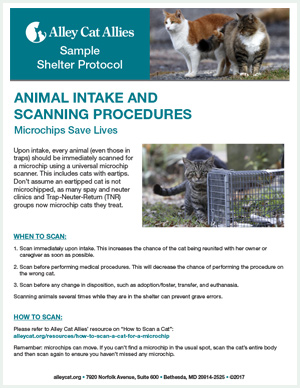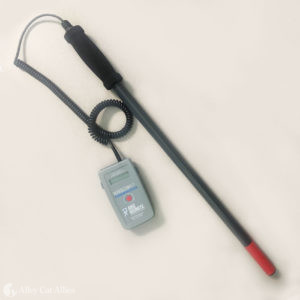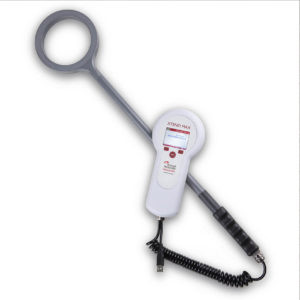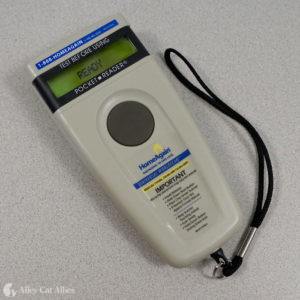Upon intake, every animal (even those in traps) should be immediately scanned for a microchip using a universal microchip scanner. This includes cats with eartips. Don’t assume an eartipped cat is not microchipped, as many spay and neuter clinics and Trap-Neuter-Return (TNR) groups now microchip cats they treat.
When to scan:
- Scan immediately upon intake. This increases the chance of the cat being reunited with her owner or caregiver as soon as possible.
- Scan before performing medical procedures. This will decrease the chance of performing the procedure on the wrong cat.
- Scan before any change in disposition, such as adoption/foster, transfer, and euthanasia.
Scanning animals several times while they are in the shelter can prevent grave errors.
How to scan:
Please refer to Alley Cat Allies’ resource on “How to Scan a Cat for a Microchip.”
Remember: Microchips can move. If you can’t find a microchip in the usual spot, scan the cat’s entire body and then scan again to ensure you haven’t missed any microchip.
If a microchip is found:
Go to American Animal Hospital Association (AAHA) Universal Pet Microchip Lookup to see which registry the microchip is registered under. Once you’ve found the registry, call or go to its website to find contact information for the animal’s owner.
If the microchip is not registered to anyone, or if the information is no longer current, call the microchip manufacturer and ask to whom the microchip was sold. This can provide a starting point to finding an owner. For example, if an animal shelter or veterinary clinic implanted the microchip, you can make calls and often successfully track down the microchipped animal’s family. Even caring people may forget to update their microchip contact information.
Note: AVID is the only major microchip provider that does not participate in AAHA microchip lookup. If you find an AVID microchip, contact the company directly.
If no microchip is found:
Check your local ordinances and shelter protocols regarding stray holding policies and implanting microchips on site. Make sure that your protocols comply with the law.
Information about scanners:
Make sure you have a universal scanner. Not all scanners and microchips are created equal. In the United States, microchips mostly function on three frequencies: 125 kHz, 128 kHz, and 134.2 kHz.
Some scanners can only detect one of these frequencies. Ensure that your organizations or clinics have a universal scanner; a scanner that can detect all three frequencies. Without a universal scanner, you will inevitably miss some microchips.
Examples of commonly used universal scanners.
- WandScan 900
- Xtend Max Scanner
- The Home Again Universal Worldscan
Additional Resource
Learn more about microchipping and the Plan to Scan Campaign





